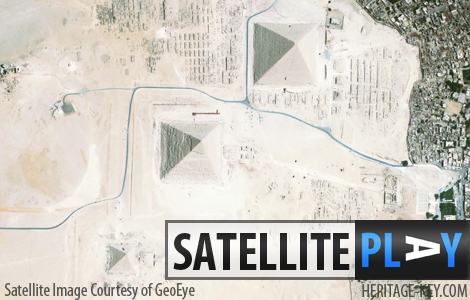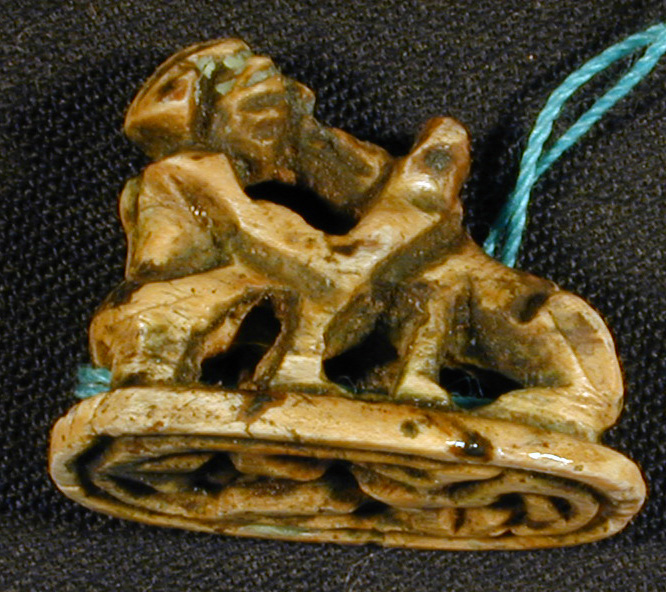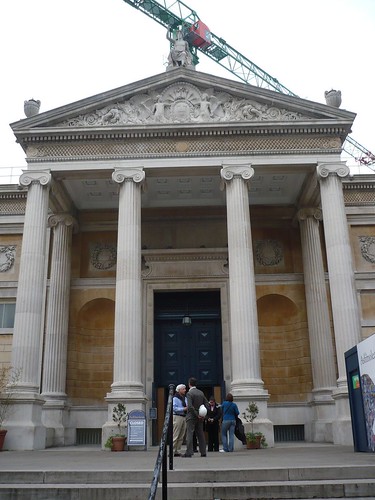The three day Egypt symposium, last weekend in Toronto, yielded a number of interesting finds. As Heritage Key has reported, researchers unravelled evidence showing that the husband of Djedmaatesankh, a mummy in the Royal Ontario museum, is now located in Chicago. Also, a large amount of info was presented on the discovery of an Amarna era fortress at Tell el-Borg. A detailed article on this can be seen here. Another key piece of research, released at the symposium, is an excavation project at the Seila pyramid. Professor Kerry Muhlestein, of Brigham Young University, delivered an update last weekend on research going…
-
-
The Pyramids of Giza at the Giza Plateau, Egypt, are one of the most famous sights in the world. It’s probably photographed from every possible angle from the ground, but often do you see it from above?Sure, Google Earth might give you an insight into aerial photography, but GeoEye has kindly given Heritage Key amazing satellite imagery at a high resolution, allowing us to see the pyramids as if we were in the space shuttle (or an alien space craft). Giza is, of course, home to the iconic Great Pyramid of Giza. Towering at 138.8 metres, it is the only…
-
A rich Roman town house discovered beneath Canterbury‘s Marlowe Theatre cannot be preserved in its present location thanks to damage from earlier modern building works. The astonishing house, complete with under-floor heating, was discovered by builders working on the famous theatre’s 26.5million redevelopment. Workers immediately got in touch with archaeologists – and work has been halted until the remains can be fully removed. Yet expert James Holden tells the BBC earlier 20th century projects have left the house in a bad state: “A lot of it has been disturbed by earlier buildings, when they built this theatre in the 30s…
-
Next Saturday Venice will be holding its own funeral. As far as publicity stunts go, it’s quite an unequivocal message that the city is on the brink. Only this time the threat is not from the rising tides and the island city’s subsiding foundations; the danger comes in the form of the rapidly shrinking population it seems that the Venetians are migrating to the mainland faster than you can say ‘just one cornetto’. According to one group of locals members of the online community venessia.com – the population has now fallen below the threshold of 60,000 people (down from about…
-
The Society for the Study of Egyptian Antiquities, and the Royal Ontario Museum,kicked off a three day symposium in Toronto. Im going to be filing more detailed blogs at the end, once I have the time to do a proper write-up of all the research. For now here are some news-briefs that I want to fill you in on. –The Seila Pyramid is flat! No it is not a step pyramid. It is a true pyramid. Professor Kerry Muhlestein of Brigham Young University, presented the latest research. A team of engineers, using GPS equipment, completed a3D model of the pyramid…
-
The oldest museum in the world reopens its doors tomorrow, after a mammoth five-year revamp. Oxford’s Ashmolean Museum has enjoyed a 61million cash injection into its ageing building, recasting all but its Victorian Cockerell building facade. Rick Mather’s new creation allows the museum’s myriad treasures much more space, adding 39 galleries and 10,000sq metres of exhibition space. The museum, founded in 1683, has been closed to the public since December last year, as the final pieces have been put in place. Funding has come from a number of high-profile sources, including the Heritage Lottery Fund, Linbury Trust (Lord Sainsbury’s charity)…
-
Attribution: jaywaykay Cairo Egypt Key Dates The museum was established in 1835. It moved to Boulaq in 1858. However the Boulaq building was destroyed in 1878. The museum moved to its current location in 1902. The Royal Mummy Room was closed in 1981, yet reopened in 1985. Key People President Anwar Sadat closed the Royal Mummy Room in 1981. The treasures of King Tutankhamun are held in the museum. Tutankhamun The Egyptian Museum of Antiquities, to give it its full name, is home to some 120,000 of the most treasured Egyptian artifacts in the country. The museum was founded in…
-
Attribution: astique Luxor Egypt Key Dates The tombs here were constructed between 1550 and 1070 BC. Key People The pharaohs of the 18th, 19th and 20th Dynasties of Ancient Egypt’s New Kingdom were buried here, along with some of their wives, children and courtiers. Standing on the west bank of the Nile, across from ancient Thebes (now Luxor), the Valley of the Kings is one of Egypts most sensitive archaeological sites. Further discoveries in 2005 and 2008 have put the total number of tombs in the necropolis at 63 and these range from simple, single pits to lavish complexes, the largest of…
-
Archaeologists exploring the lost Maya city of El Mirador claim they’ve found the world’s biggest pyramid. The massive structure, called La Danta (The Tapir), may have its summit hidden beneath Guatemala’s jungle canopy. Yet its volume is reckoned to be larger than that of the Great Pyramid of Khufu in Egypt’s Giza Plateau. The city itself, dubbed the ‘Maya Cradle of Civilization‘, is the size of a modern metropolis; bigger than downtown Los Angeles. And experts believe there are thousands more pyramids yet to be found. Yet there is more to El Mirador, tucked in Guatemala’s northern wilderness just a…
-
Toronto is a good place to be for Egyptian lovers this month. While the weather in Toronto isnt exactly like Cairo (snowfall is common during November), there is going to be lots of important Egyptian activities happening. First the big event King Tut is coming to town! The North American show, which made its last stop in Indianapolis, is opening at the Art Gallery of Ontario on November 24. Advance tickets are on sale now. The show is going to go beyond King Tuts tomb to explore Egypt as it was during the Amarna period. One of the most important…








